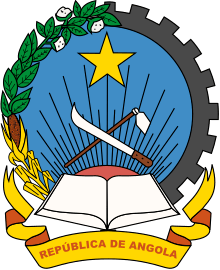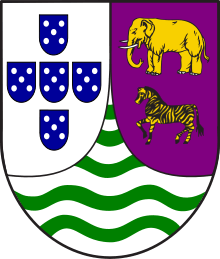Emblem of Angola
| Emblem of Angola | |
|---|---|
 | |
| Details | |
| Armiger | Republic of Angola |
| Adopted | 2 November 1990 |
| Escutcheon | azure, a machete and a hoe in saltire proper, in chief a mullet of five or, in base a rising sun orange |
| Other elements | An emblem are all enclosed within a circle formed by a half gear-wheel and a half maize and cotton leaves. At the bottom, an open book, underneath a banner with the name of the country in Portuguese |
The emblem of Angola reflects the recent past of the new nation. There is heavy Marxist imagery found on the device (as can be seen when comparing with other examples of so-called "socialist heraldry"), expanded from what is found on the national flag.
In the center is a machete and hoe, representing the revolution through which the nation gained independence and the importance of agricultural workers. Above both emblems is a star, a common symbol in socialist emblems. The star is taken to represent progress. The rising sun is the traditional symbol of a new beginning. These emblems are all enclosed within a circle whose right half is formed by cog-wheel, representing the industrial workers, and whose left half is a half-wreath of maize and cotton leaves, representing agriculture. At the bottom is an open book that represents education.
The banner at the bottom reads República de Angola, Portuguese for "Republic of Angola". This was changed from República Popular de Angola ("People's Republic of Angola") in 1990; at the same time the cog-wheel was also changed from gold to silver.
Details of the insignia are laid down in Article 163 of the Constitution of Angola.
When Angola was a Portuguese colony and later a Portuguese province (and thus legally a part of Portugal proper), Angola used coats of arms to represent the nation. These consisted of a shield parted per pale, with the Portuguese arms without its usual bordure in the dexter (viewer's left) half and in the sinister (viewer's right) half the arms for Angola itself: a golden elephant and a golden zebra on a purpure field. The wavy bars in the base (enté en point) represented Angola's location overseas from metropolitan Portugal.
Historical coats of arms
.svg.png) Coat of arms of the Portuguese Colony of Angola between May 8, 1935 - June 11, 1951.
Coat of arms of the Portuguese Colony of Angola between May 8, 1935 - June 11, 1951..svg.png) Coat of arms of the Portuguese Province of Angola, from June 11, 1951 to November 11, 1975.
Coat of arms of the Portuguese Province of Angola, from June 11, 1951 to November 11, 1975. Lesser coat of arms between May 8, 1935 - November 11, 1975.
Lesser coat of arms between May 8, 1935 - November 11, 1975..png) Emblem of the People's Republic of Angola (1975-1992)
Emblem of the People's Republic of Angola (1975-1992)